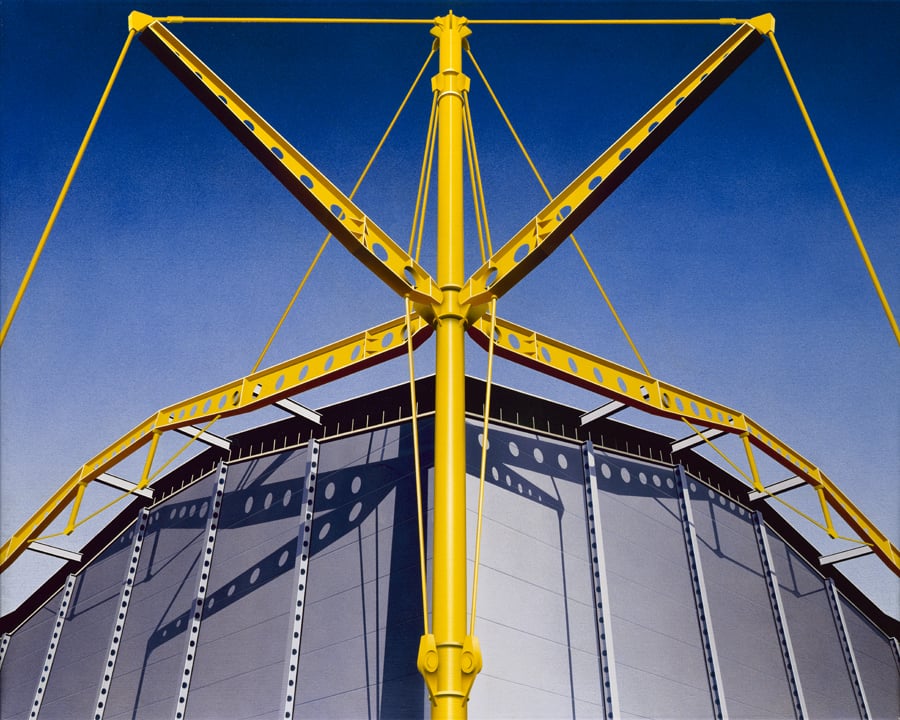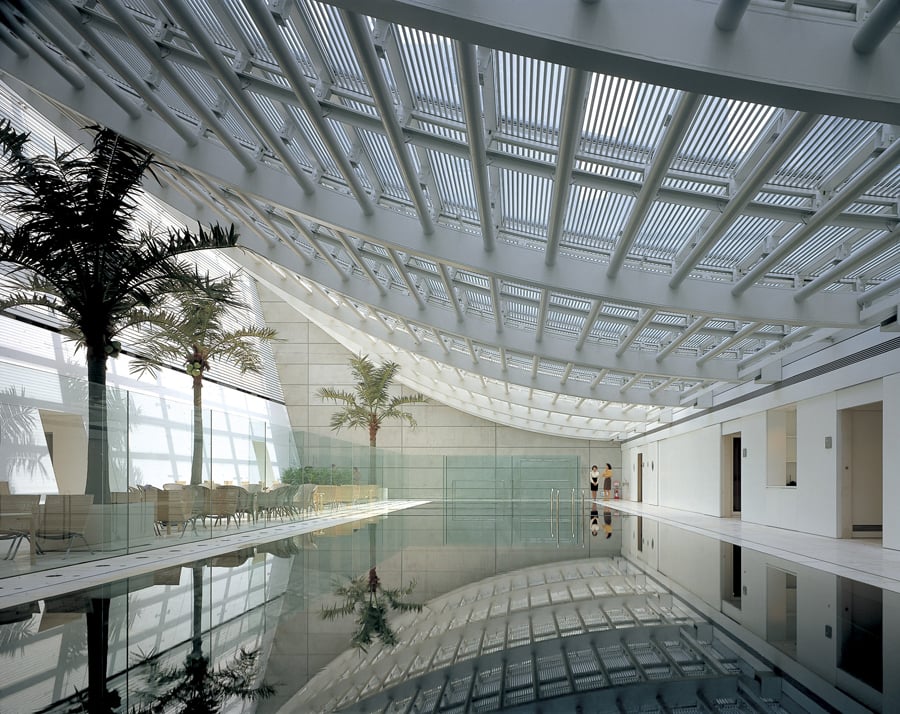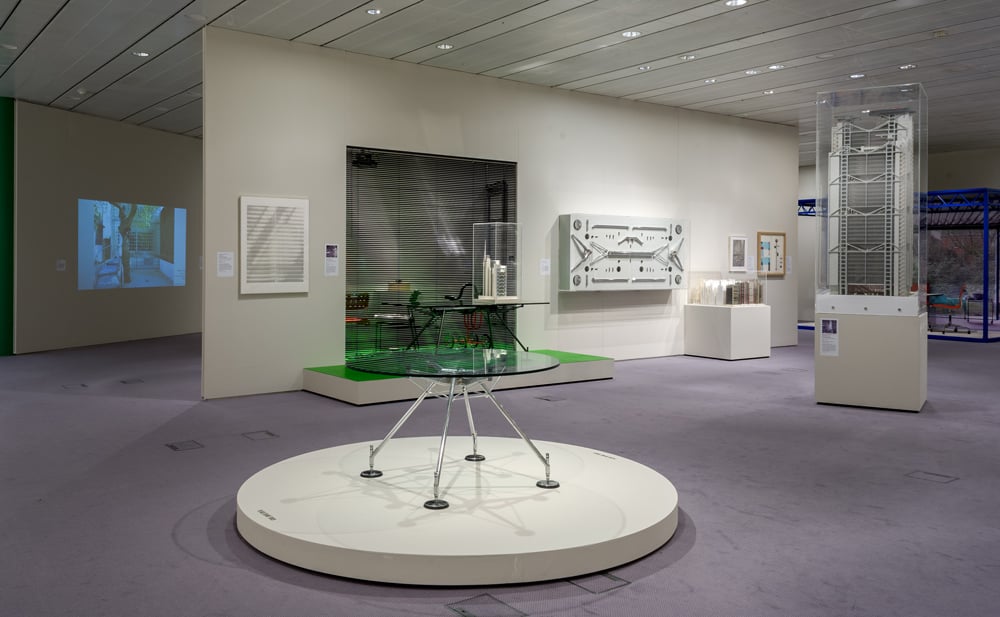
June 7, 2018
Revisiting the True Meaning of “High Tech” Architecture
A new exhibition held within a pioneering building of the so-called High Tech movement prompts a reevaluation of the relationship between architecture, technology, and structural expression.

If, in the not-so-distant future, you happen to find yourself in a spacecraft bound for interplanetary shores, chances are you will depart from a building designed by Foster + Partners. Spaceport America, more properly known as the New Mexico Spaceport Authority Building, is the first purpose-built terminal for commercial astro-tourism; as the firm tells it, it designed the sinuous, super-sustainable superhangar to intimate “the drama and mystery of space travel itself.”
In an admittedly willful parallel, Foster’s 1978 Sainsbury Centre for Visual Arts (SCVA) at the University of East Anglia in Norwich, England, is something of a precursor of the typology. It looks a little like a spaceship, only not ready to launch; rather, this smooth, white oblong alien seems to have lightly landed on a bucolic meadow, among the bunnies and wildflowers that dot the university’s spready campus. The two projects form distinct bookends in the expression of technology, reflecting the evolution of technological prosthetics and their aesthetic integration: While the spaceport, for all its visionary sustainability, appears as little more than a gentle undulation in the earth’s crust, the SCVA revels in its space-frame structure and synthetic materiality.
Pioneering in its time, the building is essentially a double-skinned steel cage, a straightforward solution that nevertheless enables a gigantic, uninterrupted 150-meter span. To preserve the continuity of that vast interior, the architects sequestered services, plants, and maintenance spaces in a void between the two skins. Offices, storage, and other utility areas were funneled underground, accessible by a passageway running through the bowels of the otherwise radiant box. The whole thing was erected with exhilarating rapidity and lightness; this is the building that famously caused American engineer and seer Buckminster Fuller to ask, “How much does your building weigh, Mr. Foster?”
The SCVA was a remarkably early commission for the young Norman Foster, the project a gift from Sir Robert and Lady Lisa Sainsbury—chiefly to the University of East Anglia, but arguably also to a new frontier in patronage. The Sainsburys were longtime art collectors and supporters of postwar luminaries such as Henry Moore, Francis Bacon, and Alberto Giacometti. In a move more common among American philanthropists, the Sainsburys decided to donate the bulk of their treasures to the university, and in 1974 commissioned the relatively unknown Foster to design a new building to house them—the architect’s first public project. As the Sainsbury Centre turns 40 this year, an ongoing exhibition, Superstructures: The New Architecture: 1960–1990, recasts the story of its creation within an expanded historical frame. In spite of its more contemporary subtitle, Superstructures draws a century-long arc from the freshly industrialized inspiration of the late 1800s to the experimental structural exuberance of what was often contentiously labeled High Tech in the late 20th century.

Why contentious? The chief anomaly is that High Tech in architecture has little to do with high technology in industry—with its connotation of electronics and computing, silicon chips and distributed communication networks. This doesn’t fully explain why most architects, whether counted among or in opposition to its authors, reject the term. Modernists objected to its stylistic associations above its purported impact. High Tech in America does refer to a style of building, but as Colin Davies points out in his 1988 book on the subject, in Britain the “movement” could be ascribed to individuals: namely, the buildings of the late 20th century designed by the likes of Foster, Richard Rogers, Michael and Patty Hopkins, and Nicholas Grimshaw, who set out an ebullient new frontier in British architecture, typified by demonstrative use of metal and glass. Even the American architectural doyen Philip Johnson observed: “There isn’t anyone in America who can do something as good as the Sainsbury Centre. England has at once become the leader in the engineering and technology game.”
In the present Brexit era, and in lesser hands, a celebration of the High Tech turn could have been shot through with a distasteful shade of jingoism. And yet Superstructures’ curators, Abraham Thomas and Jane Pavitt, present a finely calibrated narrative, and an even richer publication that consolidates the research behind it.
This includes tracing Foster’s formative influences in the United States, where, together with his onetime creative and business partner Richard Rogers, he encountered newly minted mechanized environments and system-building methods in the works of Skidmore, Owings & Merrill, Paul Rudolph, the Case Study Houses, and, of course, the utopian visions of Buckminster Fuller. While the Eameses are namechecked in a couple of wall texts, the exhibition display includes other, less-spotted engineering pioneers, such as Konrad Wachsmann or Jean Prouvé, as well as the Hungarian-born British architect Ernö Goldfinger. There is a cursory nod to High Tech aesthetics further afield, too: The Metabolists are briefly illustrated, along with architectural projects like Foster’s HSBC Building in Hong Kong.
Indeed, rather than works by the most celebrated authors, it is the historical exhibits that prove most astonishing: Joseph Paxton’s unbuilt Great Victorian Way project, illustrated in a quasireligious triptych, is probably the first example of a megastructure designed exclusively in modern materials. It proposed an extruded version of his celebrated iron-and-glass Crystal Palace running ten miles underneath central London, creating a sheltered environment including pedestrian walkways, omnibuses, and carriages, even an “elevated pneumatic railway” amid luxury residences and retail—in 1855!
Likewise it is in more paintings—namely, Ben Johnson’s photo-realistic works made more than a century later (and which alone are worth the trip to sleepy Norwich)—that the deep romanticism of the technological aesthetic is captured. More breathtaking for their visceral synthetic quality in real life than they could ever be on screen, they drip with glossy metal, neon lighting, and high saturation redolent of the 1980s.
Somewhat disappointingly, Superstructures is situated not in the main space of the SCVA but in a basement gallery, added in a 1991 refurbishment. Entering through a long corridor—at the terminus of which, two more traditional “rooms” allow one to flip round and return along the same trajectory—there’s an odd feeling of compression, particularly as one is aware of the vast expanse of space in the main gallery, itself made possible by the very architecture celebrated in this gray, corporate-carpeted passageway. In a sense, the exhibition takes place “at” the SCVA without being in any way “of ” it, and inevitably, the siting of such optimism in an unambitious setting conveys a feeling of anticlimax.
On the upside, the physical space does accentuate the smooth, linear narrative; curatorial connections cartwheel gracefully between Paxton, Arata Isozaki, and the Zünd-Up Group. Frei Otto’s beautiful film tests of soap bubbles and their tensile integrity—again, alone worth traveling to see—lead effortlessly to Fuller’s geodesic domes and the taut structures of Félix Candela. Throughout, the explanatory texts are informative without being intrusive, guiding the viewer through the logical sequence of exhibits.
The slick, obscure minimalism that is the prevalent language of today’s tech world—perhaps best embodied by Apple, whose new HQ, Apple Park, was designed by none other than Foster + Partners—is counterbalanced by all manner of earthy or nostalgic trends, among them the recurrent steampunk and its overt fetish for obsolete technologies. Today’s “high tech” is in many ways more ephemeral than anything previously suggested, except perhaps in science fiction: smooth transactions of global culture and fi nance, and virtual modeling not only of designs but also of societies and opinions.
Yet a visibly technocratic aesthetic is not merely a reaction against history or slickness. Superstructures describes but one chapter among many others, between the would-be-utopian (but also warmongering) rhetoric of the Italian Futurists and the psychedelic technoutopianism of Archigram, in which feats of engineering are made more wonderful by the awesome—in the literal sense—achievements of mankind, emphasized by the palpable, visible, and exaggerated presence of technology.
In the opening chapter of the exhibition catalog, the curators quote the Norwich-born author Reyner Banham, still the best commentator on the architectural advances of the postwar decades: “The architect who proposes to run with technology knows now he will be in fast company, and that, in order to keep up, he may have to emulate the Futurists and discard his whole cultural load, including the professional garments by which he is recognised as an architect.”
The curators omit the end of that quotation from Theory and Design in the First Machine Age (1960), and rightly so, as the works on display elevate both the engineer and the architect in a narrative of superlative achievement. But it’s interesting to think of Banham’s follow-up, which predicted that the architect who fails to shed his “cultural load,” as he put it, “may find that a technological culture has decided to go on without him.” It is a challenge that brings much more to bear on the role of the profession today.
Superstructures: The New Architecture: 1960–1990 is open through September 2, 2018.
You may also enjoy “These Architects Sought to Solve the Ultimate Human Design Flaw—Death.”












